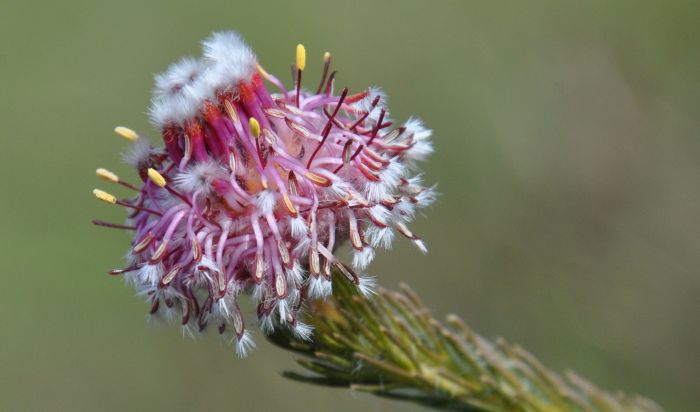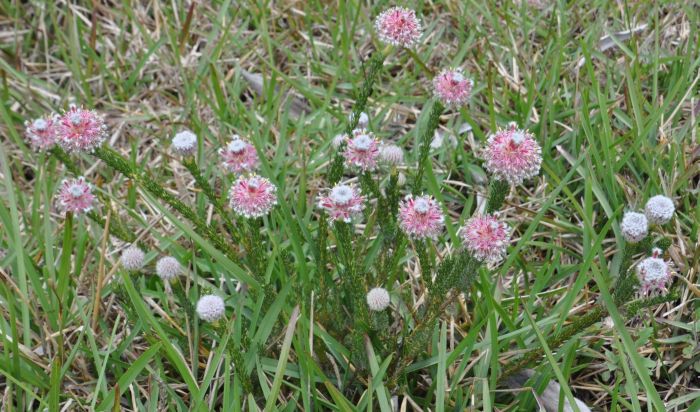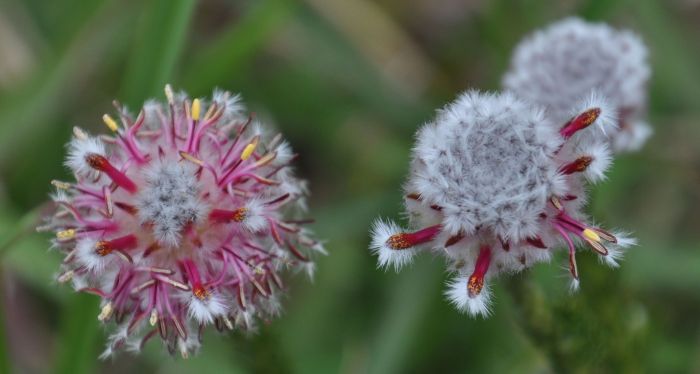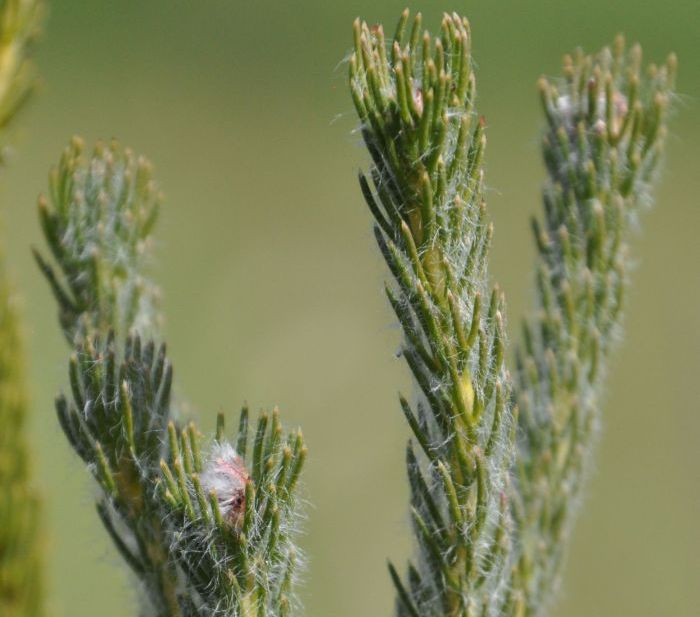Serruria trilopha
Serruria trilopha Salisb. ex Knight
Family: Proteaceae
Common names: trident spiderhead, sand spiderhead, snake-stem spiderhead, three-crested spiderhead (Eng.); slangspinnekopbos (Afr.)
Introduction
This critically endangered member of the protea family makes an unusual addition to sandy coastal gardens.

Description
Description
Serruria trilopha is a sprawling, multi-stemmed, resprouting shrub. It grows to a height of 0.3-0.8 m and has a spread of up to 0.8 m. The short, dissected leaves, which are characteristic of serrurias, are hairless when mature. The plant produces a coconut-scented, pink flowerhead during spring to early summer (from August to October). The seeds are released within two months of flowering.

Conservation Status
Status
The Red List of South African Plants categorizes this species as Critically Endangered (CR). The wild population has declined by at least 80% because much of its range and habitat are gone with about five small, scattered subpopulations remaining. It is threatened by invasive alien plants, alien ants, mowing, overgrazing, too-frequent fire and the expansion of housing and farms.

Distribution and habitat
Distribution description
Serruria trilopha grows in acid, sandy soils at low altitudes between 50-310 m on the Cape Flats. The plant experiences typical Western Cape weather which is cool and wet during winter and hot, dry and windy during the summer months. The Trident Spiderhead is naturally a lowland species and was once widespread over the Cape Peninsula, Cape Flats and as far north as Malmesbury and Darling. The species is endangered mainly because of rapid urbanization, invasive aliens taking over its habitat and agriculture. According to Tony Rebelo (1999) there are less than 500 plants that remain in the wild, and most of them are along the road verges of the N7 freeway in the Cape Town area.
Derivation of name and historical aspects
History
The genus was named after J. Serrurier, a professor of botany at the University of Utrecht in the early eighteenth century. The species name trilopha refers to the short leaves that are dissected into three segments. The common name snake-stem spiderhead refers to the long and robust stems which 'snake' along the ground.

Ecology
Ecology
Serruria trilopha is adapted to surviving in the wild by reproducing from seed. Once the seed ripens it is shed from the flowers and falls to the ground. The seeds are tiny, hard-shelled, oval nuts covered by a fleshy skin called the elaisome. The elaisome secretes a chemical substance that attracts ants. The ants carry the seeds to their underground nests where the fleshy skin is consumed. The seeds remain underground until conditions are right for germination.
Serruria trilopha is adapted to surviving fires by resprouting. Although the above-ground parts of the plant are burnt, the plant bounces back and resprouts. The plants may flower profusely the year following a fire, and will grow strongly and flower well in the first two years after a fire, but will flower less and become straggly thereafter.

Growing Serruria trilopha
Grow
Serruria trilopha can be grown from cuttings or seed. Tip or heel cuttings are taken during spring or autumn. A rooting hormone is applied to the semi-hardwood cuttings. The rooting hormone will help stimulate rooting. The cuttings are rooted in a soil mixture of 50% milled pine bark and 50% polystyrene granules. Successful rooting will happen if the propagation house has good misting and underbench heating. Rooting of this species takes quite long, up to 6-7 weeks. Once rooted the cuttings are removed from the mist bench and hardened off for 4 weeks. The hardened-off cuttings are then potted in a soil mixture made up especially for fynbos plants. A suitable well-drained soil mixture consists of composted pine bark, acidic river sand in equal parts loam/topsoil.
Seed is collected from the mature flowerhead. The seed should be sown in late summer or early autumn (March-April). The higher day temperatures and cooler night temperatures play a vital role in initiating germination. The seeds can also be exposed to short periods of high temperatures followed by cooling water, which, by copying the autumn temperature, stimulates the seed to germinate. The seeds should be treated with a fungicide that prevents pre- and post-emergence damping off. The young seedling or cuttings should be grown in an area that is well ventilated and covered with 50% green shade netting. The plants should be watered in the mornings and you can feed with an organic-based fertilizer to boost their growth. The young plants can be planted out in autumn or in the cooler months before the onset of summer. This will allow the root system to become established and gives the young plant a good chance of surviving the hot summer months.
Serruria trilopha is best suited for a garden that has sandy soil. It is a relatively small shrub so plant it in your garden among slightly taller growing plants. The plant is a resprouter so you could prune it occasionally to keep it neat and compact. Plant in full sunlight and a layer of composted mulch or woodchips will help keep the soil cool and provide the plant with nourishment.
References
- Rebelo, A. G. 1995. Sasol proteas. A field guide to the proteas of southern Africa. Fernwood Press, Cape Town.
- Rebelo, A. G. 1999. West Coast proteas. A field guide to the proteas of the West Coast. Protea Atlas Project, National Botanical Institute, Cape Town.
- Vogts, M. 1982. South Africa's Proteaceae. Know them and grow them. Struik, Cape Town.
Credits
Trevor Adams
Kirstenbosch National Botanical Garden
October 2003
updated September 2019
Plant Attributes:
Plant Type: Shrub
SA Distribution: Western Cape
Soil type: Sandy, Loam
Flowering season: Spring
PH: Acid
Flower colour: White, Pink
Aspect: Full Sun
Gardening skill: Challenging
Special Features:
Horticultural zones







Rate this article
Article well written and informative
Rate this plant
Is this an interesting plant?
Login to add your Comment
Back to topNot registered yet? Click here to register.